
Arnica is a genus of perennial, herbaceous plants in the sunflower family (Asteraceae). The genus name Arnica may be derived from the Greek arni, "lamb", in reference to the plants' soft, hairy leaves. Arnica is also known by the names mountain tobacco and confusingly, leopard's bane and wolfsbane—two names that it shares with the entirely unrelated genus Aconitum.

Hulsea brevifolia is a species of flowering plant in the family Asteraceae known by the common name shortleaf alpinegold, or shortleaf hulsea. It is endemic to California, where it is an uncommon resident of the High Sierra. It is found between 6,000–8,000 feet (1,800–2,400 m) in elevation.
Hulsea nana is a North American species of flowering plant in the family Asteraceae known by the common name dwarf alpinegold. It is native to the western United States from Washington, Oregon, and far northern California.
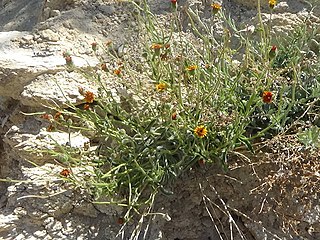
Hulsea vestita is a species of flowering plant in the family Asteraceae known by the common name pumice alpinegold.

Chaenactis artemisiifolia, with the common name white pincushion, is a species of flowering plant in the daisy family. It is native to the coastal Peninsular Ranges of Southern California and Baja California, in the chaparral and woodlands.
Arnica cernua is a species of arnica known by the common name serpentine arnica. It is native to the Klamath Mountains of northern California and southern Oregon, where it is a member of the serpentine soils flora.
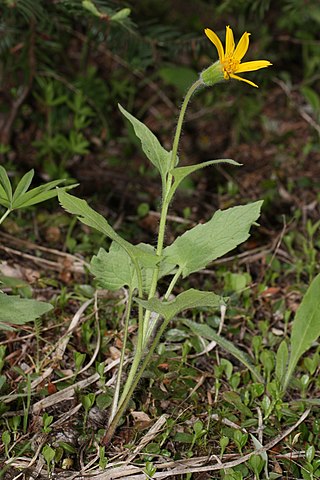
Arnica cordifolia is a species of arnica in the sunflower family, known by the common name heartleaf arnica. It is native to western North America.

Arnica discoidea is a North American species of arnica in the sunflower family. It is known by the common name rayless arnica because its flower heads have disc florets but none of the showier ray florets. It is native to the woodlands, forests, and chaparral of the western United States (Washington, Oregon, California, and western Nevada.
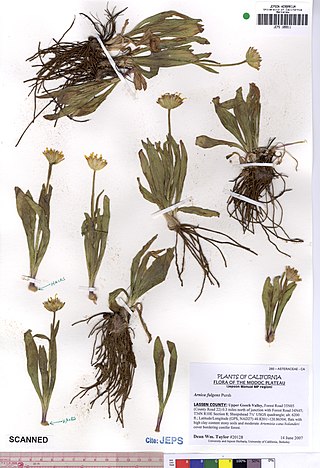
Arnica fulgens is a species of arnica known by the common names foothill arnica and hillside arnica. It is native to western North America, from British Columbia east to Saskatchewan and south as far as Inyo County, California, and McKinley County, New Mexico. It grows in open, grassy areas.
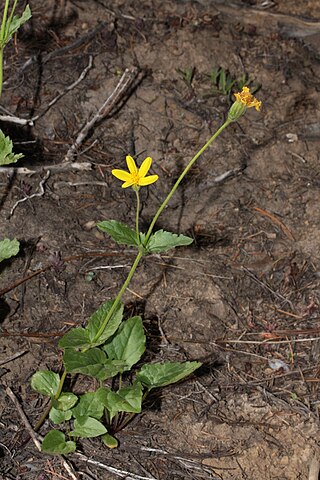
Arnica latifolia is a species of arnica in the sunflower family, known by the common names broadleaf arnica, broad leaved arnica, mountain arnica, and daffodil leopardbane. It is native to western North America from Alaska east to Northwest Territories and south to Mono County, California, and Taos County, New Mexico. It grows in mountain habitat such as forest and meadows.
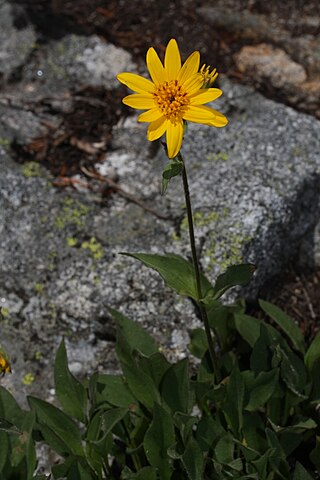
Arnica mollis is a North American species of arnica in the sunflower family, known by the common name soft arnica, or hairy arnica. It is native to Canada and the United States (Alaska and the western mountains as far south as San Bernardino County, California and Rio Arriba County, New Mexico. There are also isolated populations in the White Mountains of Coos County, New Hampshire. The species grows in subalpine mountain habitat such as meadows and streambanks.

Arnica nevadensis is a North American species of arnica in the sunflower family, known by the common names Nevada arnica and Sierra arnica. It is native to the coniferous forests of the western United States, primarily the Cascades and Sierra Nevada.

Arnica sororia is a North American species of flowering plant known by the common name twin arnica. It is native to Western Canada and the Western United States. It grows in grasslands and in conifer forests, as well as the sagebrush steppe.
Arnica spathulata is a rare North American species of flowering plant in the family Asteraceae, known by the common name Klamath arnica. It is native to the Klamath Mountains of northwestern California and southwestern Oregon. It grows in woodland habitat, almost exclusively on serpentine soils.
Arnica viscosa is an uncommon North American species of flowering plant in the family Asteraceae, known by the common name Mount Shasta arnica.

Erigeron tener is a North American species of flowering plant in the family Asteraceae known by the common name slender fleabane. It is native to the western United States, largely in the Great Basin, in the states of California, Arizona, Nevada, Utah, Oregon, Wyoming, Idaho, and Montana.

Solidago spectabilis is a species of goldenrod known by the common names Nevada goldenrod, basin goldenrod, and showy goldenrod. It is native to the western United States in the Great Basin and surrounding areas. It is found in California, Arizona, Nevada, Oregon, and Utah. There are historical records saying it once grew in southwestern Idaho, but is now extirpated there. This variety has also been seen in the western Montana county of Sanders.

Arnica dealbata is a species of Californian plants in the tarweed tribe within the aster family

Cirsium parryi, or Parry's thistle, is a species of North American flowering plants in the family Asteraceae. It is native to the southwestern United States, where it has been found in Colorado, Arizona, and New Mexico.

Ericameria parryi is a species of flowering plant in the family Asteraceae known by the common name Parry's rabbitbrush. It is native to much of the western United States.

















